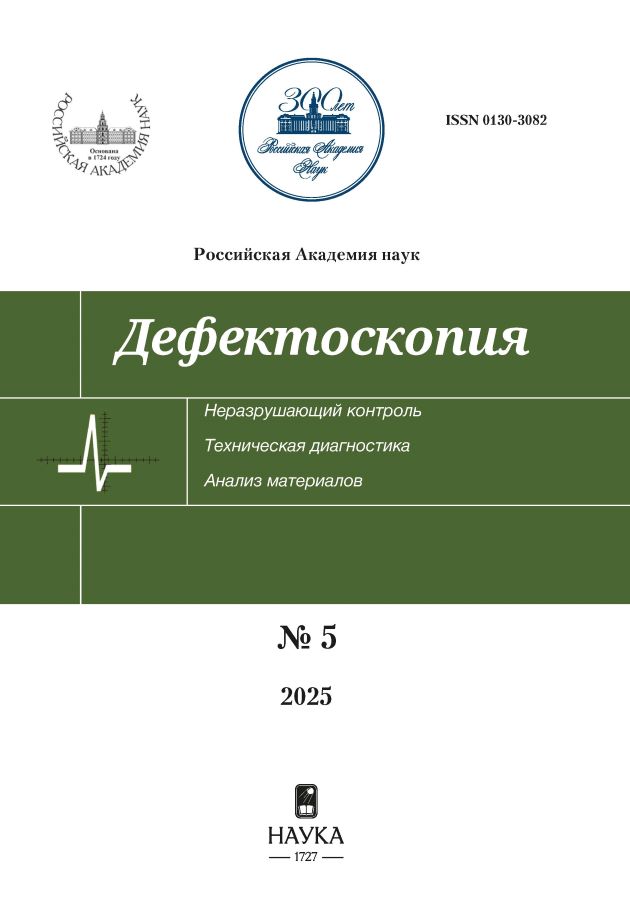Application of acoustic emission and vibration diagnostics methods in compression testing of composite specimens
- Autores: Matvienko Y.G.1, Vasiliev I.E.1, Fursov V.Y.1
-
Afiliações:
- Mechanical Engineering Research Institute of the Russian Academy of Science
- Edição: Nº 5 (2025)
- Páginas: 17-28
- Seção: Acoustic methods
- URL: https://vestnik-pp.samgtu.ru/0130-3082/article/view/684110
- DOI: https://doi.org/10.31857/S0130308225050024
- ID: 684110
Citar
Texto integral
Resumo
The methodology of joint application of acoustic emission diagnostics (AED), vibration diagnostics (VBD) and videotaping for monitoring the load-bearing capacity of polymer composite material (PCM) specimens during compression tests is considered. The test specimens cut from the composite panel were divided into five groups of two specimens each. Before the compression test, the specimens of the second group were subjected to an impact with an energy of 50 J, the third group with 70 J, the fourth group with 90 J, and the fifth group with 110 J. Assessment of the state of damage of the specimens during compression was carried out using AED, IAP and video recording. The obtained results confirmed the high efficiency of the complex application of these methods. Their joint application allowed not only to monitor the level of bearing capacity of specimens in the loading mode, but also at the stage of ultimate deformation of the material to trace the sequence of mechanisms of evolution of multilayer carbon fiber-reinforced plastic fracture in compression.
Palavras-chave
Texto integral
Sobre autores
Yury Matvienko
Mechanical Engineering Research Institute of the Russian Academy of Science
Email: ygmatvienko@gmail.com
Código SPIN: 2085-8281
Rússia, 101990 Moscow, Maly Kharitonyevsky Lane, 4
Igor Vasiliev
Mechanical Engineering Research Institute of the Russian Academy of Science
Email: vie01@rambler.ru
Código SPIN: 2770-5114
Rússia, 101990 Moscow, Maly Kharitonyevsky Lane, 4
Valery Fursov
Mechanical Engineering Research Institute of the Russian Academy of Science
Autor responsável pela correspondência
Email: 97dis@mail.ru
ORCID ID: 0009-0001-0456-7034
Rússia, 101990 Moscow, Maly Kharitonyevsky Lane, 4
Bibliografia
- GOST 33495—2015. Kompozity polimernyye. Metod ispytania na szhatiye posle udara / M.: Standartinform, 2016. 20 s. [In Russian].
- ASTM D 7137 / D7137M — 17. Standard Test Method for Compressive Residual Strength Properties of Damaged Polymer Matrix Composite Plates / TBT Committee. Last Up. June 14. 2023. 16 p.
- Composite Materials. Handbook. Vol. 3. Polymer matrix composites materials usage, design, and analysis. Series MIL-HDBK-17/Department of Defense USA. Fort Washington: Materials Sciences Corporation. 2002.
- Dudarkov Yu.I., Limonin M.V. Local buckling laminated composite at impact damage area // Mechanics of composite materials and structures. 2023. V. 29. No. 1. P. 35—53. [In Russian].
- Golovan V.I., Dudarkov Yu.I., Levchenko Е.А., Limonin М.V. Nesushhaya sposobnost’ panelej iz kompozitsionnykh materialov pri nalichii ehkspluatatsionnykh povrezhdenij [Load bearing capacity of composite panels with in-service damages] // Trudy МАI. 2020. No.110. P. 5—26. [In Russian].
- Molkov O.R., Bolshikh A.A. Method of determining the elastic properties degradation level in the heavy gage composite panels exposed to the low-velocity impact action // Inzhenernyij zhurnal nauka i innovacii. 2024. No. 8. P. 1—22. [In Russian].
- Mitryaykin V.I., Bezzametnov O.N. Strength of multilayered plates with impact damage // Uchenye Zapiski Kazanskogo Universiteta. Seriya Fiziko-Matematicheskie Nauki. 2022. V. 164. No. 2—3. P. 206—220. [In Russian].
- Kudryavtsev O.A., Olivenko N.A., Sapozhnikov S.B., Ignatova A.V., Bezmelnitsyn A.V. Characterization of damages and the residual flexural strength of layered composites after low-velocity impacts using indicator coatings // Mechanics of composite materials. 2021. V. 57. No. 5. P. 839—852. [In Russian].
- Wagih A., Sebaey T. A., Yudhanto A. and Lubineau G. Post-impact flexural behavior of carbon-aramid/epoxy hybrid composites // Composite Struct. 2020. V. 239. P. 1120—1122.
- Sun C., Hallett R. Failure mechanisms and damage evolution of laminated composites under compression after impact (CAI): Experimental and numerical study // Composites Part A: Applied Science and Manufacturing. 2018. V. 104. Р. 41—59.
- Makhutov N. A., Vasiliev I.E., Fursov V.Yu, Skvortsov D.F. Combined application of acoustic emission and vibration diagnostics in statistical tensile tests of samples with a combined stress concentrator // Journal of Machinery Manufacture and Reliability. 2024. V. 53. Suppl. 2. P. S197—S203.
- Vasiliev I.E. Kompleksnoe opredelenie deformirovannogo, povrezhdennogo i predelnogo sostojania pri mehanicheskom-vozdejstvii / Disser. … doktora tehnicheskih nayk. M.: MGTY im. N.E. Baymana, 2024. 331 p. [In Russian].
- Matvienko Yu.G., Makhutov N.A., Vasiliev I.E., Chernov D.V. Monitoring of the composite materials destruction kinetics using acoustic-emission diagnostics // Zavod. Labor. Diagn. Mater. 2024. V. 90. No. 11. P. 53—66. [In Russian].
- Matvienko Yu.G., Vasil’ev I.E., Chernov D.V. Application of acoustic emission and video recording for monitoring the kinetics of damage during compression of composite specimens // Zavod. Labor. Diagn. Mater. 2021. V. 87. No. 4. P. 45—61. [In Russian].
- Bigus G.A., Daniev Y.F., Bystrova N.A., Galkin D.I. Fundamentals of diagnostics of technical devices and structures. Moscow: The Bauman University Publishing House, 2015. 445 p. [In Russian].
- Egorova E.V., Aksjaitov M.H., Rybakov A.N. Metody povyshenija jeffektivnosti vejvlet preobrazovanij pri obrabotke szhatii i vosstanovlenija radiotehnicheskih signalov. Monografija. Tambov: Konsalt. Komp. «Jukom», 2019. 84 p. [In Russian].
- Ivanov V.E., Un Che En. Modulnye vejvlet filtry: modeli algoritmy i sredstva / Pod red. Una Che Ena. Habarovsk: Izd. TOGU, 2020. 175 p. [In Russian].
- Mallat S.G. A Wavelet Tour of Signal Processing. The Sparse Way. Elsevier: Academic Press, 2009. 805 p.
- Aslamov Yu.P., Aslamov A.P., Davydov I.G., Tsurko A.V. Efficiency of scalogram use for assessment of the technical condition of rotary equipment // Doklady BGUIR. 2018. V. 112. Nо. 2. P. 12—17. [In Russian].
- Gulai A.V., Zaitsev V.M. Intelligent technology of wavelet analysis of vibration signals // Doklady BGUIR. 2019. V. 126. Nо. 7—8. P. 102—108. [In Russian].
Arquivos suplementares





















